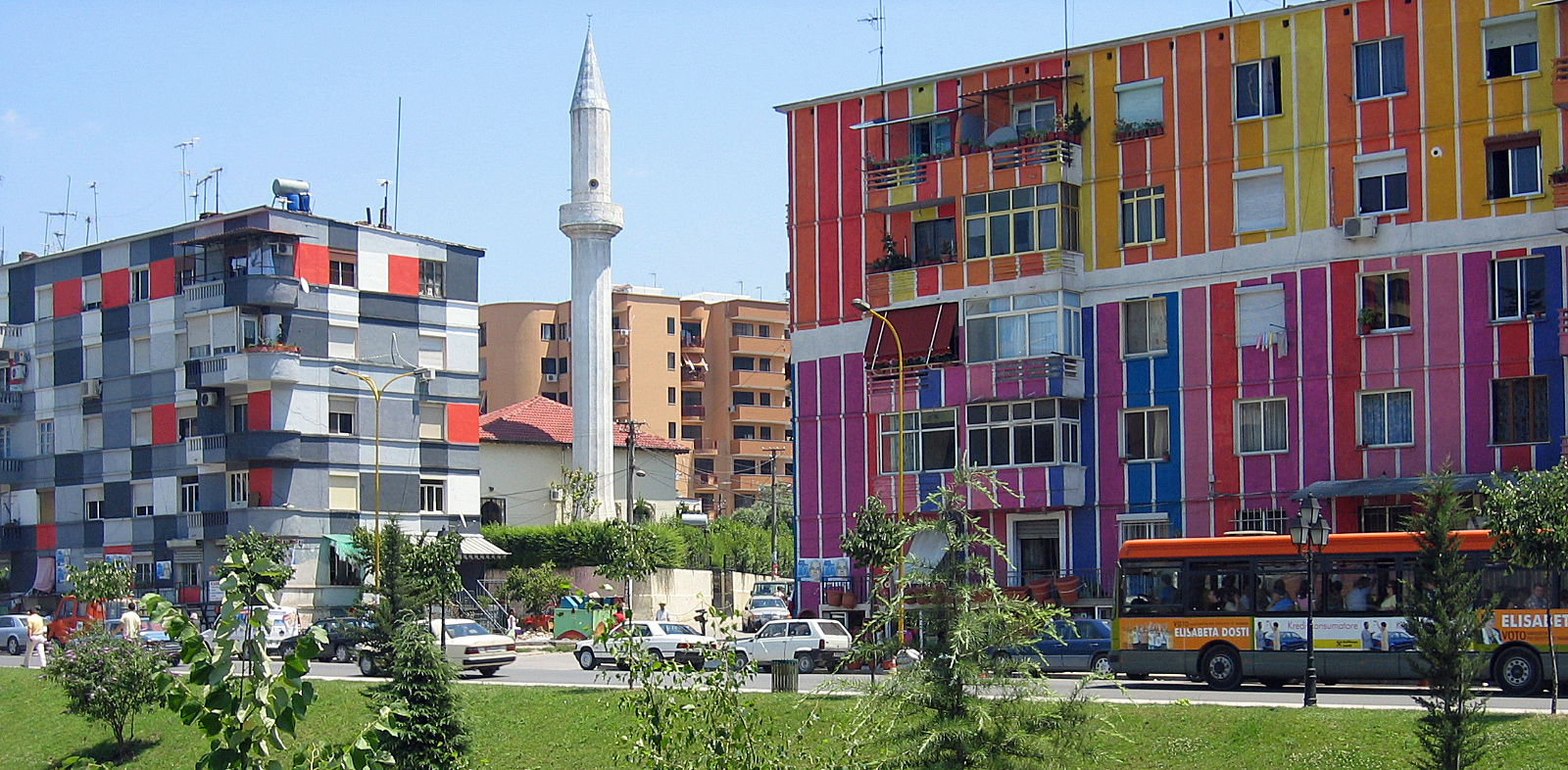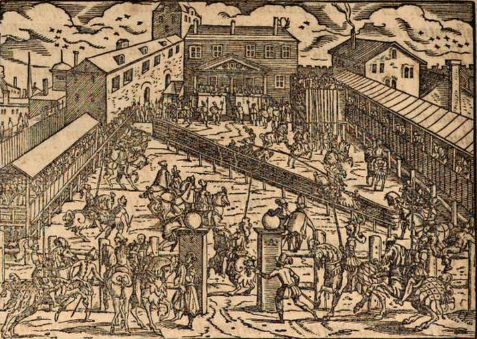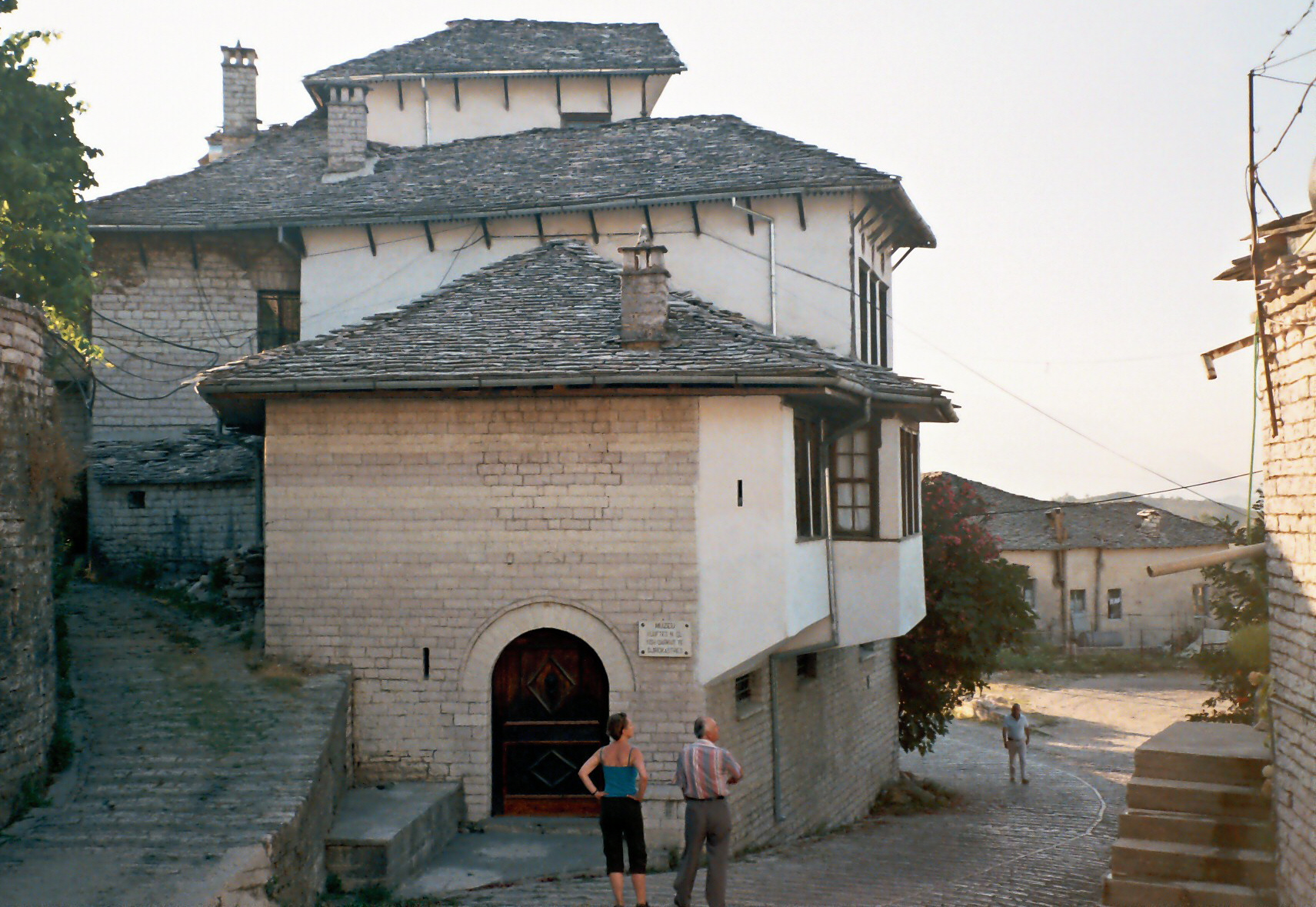|
Skanderbeg Square
The Skanderbeg Square () is the main plaza in the centre of Tirana, Albania. The square is named after the Albanian national hero Gjergj Kastrioti Skënderbeu. The total area is about 40,000 square metres. The Skanderbeg Monument dominates the square. The city plan for Tirana was initially designed by Armando Brasini in 1925 and continued by Florestano Di Fausto in a Neo-Renaissance style with articulate angular solutions and giant order fascias. Following the Italian invasion of Albania the master plan was updated in 1939 by Gherardo Bosio. Many buildings including the Tirana International Hotel, the Palace of Culture, the National Opera, the National Library, the National Bank, the Ethem Bey Mosque, the Clock Tower, the City Hall, the Ministry of Infrastructure, the Ministry of Agriculture, the Ministry of Economy, the Ministry of Energy, and the National Historical Museum are situated at the square. History In 1917, the Austrians built a public square, where the Skand ... [...More Info...] [...Related Items...] OR: [Wikipedia] [Google] [Baidu] |
Tirana
Tirana ( , ; aln, Tirona) is the capital and largest city of Albania. It is located in the centre of the country, enclosed by mountains and hills with Dajti rising to the east and a slight valley to the northwest overlooking the Adriatic Sea in the distance. Due to its location at the Plain of Tirana and the close proximity to the Mediterranean Sea, the city is particularly influenced by a Mediterranean seasonal climate. It is among the wettest and sunniest cities in Europe, with 2,544 hours of sun per year. Tirana was founded as a city in 1614 by the Ottoman Albanian general Sylejman Pasha Bargjini and flourished by then around the Old Mosque and the ''türbe''. The area that today corresponds to the city's territory has been continuously inhabited since the Iron Age. It was inhabited by Illyrians, and was most likely the core of the Illyrian Kingdom of the Taulantii, which in Classical Antiquity was centred in the hinterland of Epidamnus. Following the Illyrian Wars it wa ... [...More Info...] [...Related Items...] OR: [Wikipedia] [Google] [Baidu] |
Ministry Of Transportation And Infrastructure (Albania)
The Ministry of Transport () was a department of the Albanian Government responsible for the transport, infrastructure, technical standards, water supply and sanitation, and urban waste management. History Reorganization Since the establishment of the institution, the Ministry of Transport has undergone several administrative changes to its organizational structure. When a new department was formed, it often merged with the ministry thus expanding its role, subsequently leading to the name of the ministry being changed. If that department later broke off as a separate ministry or was dissolved, the ministry reverted to its original name. * Ministry of Transport (1987–1991) * Ministry of Transports (1991–1992) * Ministry of Transports and Communications (1992–1994) * Ministry of Industry, Transport and Trade (1994–1997) * Ministry of Public Works and Transport (1997–1999) * Ministry of Transport (1999–2002) * Ministry of Transports and Telecommunication (2002–2005) ... [...More Info...] [...Related Items...] OR: [Wikipedia] [Google] [Baidu] |
Europeanisation
Europeanisation (or Europeanization, see spelling differences) refers to a number of related phenomena and patterns of change: *The process in which a notionally non-European subject (be it a culture, a language, a city or a nation) adopts a number of European features (often related to Westernization). *Outside the social sciences, it commonly refers to the growth of a European continental identity or polity over and above national identities and polities on the continent. *Europeanisation may also refer to the process through which European Union political and economic dynamics become part of the organisational logic of national politics and policy-making. Definitions Europeanisation in political science has been referred to very generally as 'becoming more European like'. More specifically than this, it has been defined in a number of ways. One of the earliest conceptualisations of the term is by Ladrech (1994, 69), who defines Europeanisation simply as ‘an incremental proces ... [...More Info...] [...Related Items...] OR: [Wikipedia] [Google] [Baidu] |
Modernization
Modernization theory is used to explain the process of modernization within societies. The "classical" theories of modernization of the 1950s and 1960s drew on sociological analyses of Karl Marx, Emile Durkheim and a partial reading of Max Weber, and were strongly influenced by the writings of Harvard sociologist Talcott Parsons. Modernization theory was a dominant paradigm in the social sciences in the 1950s and 1960s, then went into a deep eclipse. It made a comeback after 1991, when Francis Fukuyama wrote about the end of the Cold War as confirmation on modernization theory and more generally of universal history. But the theory remains a controversial model. Modernization refers to a model of a progressive transition from a "pre-modern" or "traditional" to a "modern" society. Modernization theory suggests that traditional societies will develop as they adopt more modern practices. Proponents of modernization theory claim that modern states are wealthier and more powerful and t ... [...More Info...] [...Related Items...] OR: [Wikipedia] [Google] [Baidu] |
Edi Rama
Edi Rama (born Edvin Kristaq Rama, 4 July 1964) is an Albanian politician, painter, writer, former university lecturer, publicist and former basketball player, who has served as the 33rd and current Prime Minister of Albania since 2013 and chairman of the Socialist Party of Albania since 2005. Prior to his tenure as Prime Minister, Rama held a number of positions. He was appointed Minister of Culture, Youth and Sports in 1998, an office he held until 2000. First elected mayor of Tirana in 2000, he was reelected in 2003 and 2007. The coalition of centre-left parties led by Rama in the 2013 parliamentary election defeated the centre-right coalition around the Democratic Party of Albania of incumbent Prime Minister Sali Berisha. Rama was appointed Prime Minister for a second term following the 2017 election. Rama won a third mandate following the 2021 parliamentary election in which he defeated the Democratic Party of Albania candidate, Lulzim Basha, for the second time in a row ... [...More Info...] [...Related Items...] OR: [Wikipedia] [Google] [Baidu] |
Skanderbeg Square Under Reconstruction
Gjergj Kastrioti ( la, Georgius Castriota; it, Giorgio Castriota; 1405 – 17 January 1468), commonly known as Skanderbeg ( sq, Skënderbeu or ''Skënderbej'', from ota, اسکندر بگ, Iskandar, İskender Bey; it, Scanderbeg), was an Albanian nobility, Albanian feudal lord and military commander who led Skanderbeg's rebellion, a rebellion against the Ottoman Empire in what is today Albania, North Macedonia, Greece, Kosovo, Montenegro, and Serbia. A member of the noble House of Kastrioti, Kastrioti family, he was sent as a hostage to the Ottoman court. He was educated there and entered the service of the Ottoman sultan for the next twenty years. His rise through the ranks culminated in his appointment as ''sanjakbey'' (governor) of the Sanjak of Dibra in 1440. In 1443, during the Battle of Niš (1443), Battle of Niš, he deserted the Ottomans and became the ruler of Krujë and the nearby areas extending from central Albania to Kodžadžik, Sfetigrad, and Modrič, Struga, Modri ... [...More Info...] [...Related Items...] OR: [Wikipedia] [Google] [Baidu] |
Chicago Architecture Biennial
The Chicago Architecture Biennial is an international exhibition of architectural ideas, projects and displays. It seeks "to provide a platform for groundbreaking architectural projects and spatial experiments that demonstrate how creativity and innovation can radically transform our lived experience." Founded in 2014, the biennial is managed by a charitable corporation under the auspices of the city's Cultural Affairs department, and sponsored by public and private organizations and individuals. Expositions The first of its kind in North America, the inaugural iteration of the biennale took place in Chicago between October, 2015 and January, 2016, and was headquartered at the Chicago Cultural Center. Its first directors were Sarah Herda and Joseph Grima. The event was championed by then-mayor Rahm Emanuel who told the ''Financial Times'': "This biennial is an ode to the city's past and an echo to our future." The 2015-16 biennial had entries from 104 architects or practices. The ... [...More Info...] [...Related Items...] OR: [Wikipedia] [Google] [Baidu] |
European Prize For Urban Public Space
The European Prize for Urban Public Space is a biennial award established in 2000 to recognise public space projects. It is organised by the Centre de Cultura Contemporània de Barcelona together with six other European institutions: The Architecture Foundation, Cité de l'Architecture et du Patrimoine, Architekturzentrum Wien, Netherlands Architecture Institute, German Architecture Museum and the Museum of Finnish Architecture The Museum of Finnish Architecture ( fi, Suomen arkkitehtuurimuseo, sv, Finlands arkitekturmuseum) is an architectural museum in Helsinki, Finland. Established in 1956, it is the second oldest museum of its kind (after the Shchusev Museum of Arc ....A10"European Prize for Urban Public Space", 1 May 2010 The number of nominations for the prize increased from 81 projects in 2000 to 347 projects in 2012, while the number of countries participating increased form 14 in the first year to 36 in 2012.Architecture Today"Ljubljana/ Barcelona: Winners of the 2012 Eu ... [...More Info...] [...Related Items...] OR: [Wikipedia] [Google] [Baidu] |
Enver Hoxha
Enver Halil Hoxha ( , ; 16 October 190811 April 1985) was an Albanian communist politician who was the authoritarian ruler of Albania from 1944 until his death in 1985. He was First Secretary of the Party of Labour of Albania from 1941 until his death in 1985. He was also a member of the Politburo of the Party of Labour of Albania, chairman of the Democratic Front of Albania, and commander-in-chief of the armed forces and ruled the country from 1944 until his death in 1985. He was the 22nd Prime Minister of Albania from 1944 to 1954 and at various times was both foreign minister and defence minister of the People's Socialist Republic of Albania. Hoxha was born in Gjirokastër in 1908 and became a grammar school teacher in 1936. Following the Italian invasion of Albania, he joined the Party of Labour of Albania at its creation in 1941 in the Soviet Union. He was elected First Secretary in March 1943 at the age of 34. Less than two years after the liberation of the country ... [...More Info...] [...Related Items...] OR: [Wikipedia] [Google] [Baidu] |
Joseph Stalin
Joseph Vissarionovich Stalin (born Ioseb Besarionis dze Jughashvili; – 5 March 1953) was a Georgian revolutionary and Soviet political leader who led the Soviet Union from 1924 until his death in 1953. He held power as General Secretary of the Communist Party of the Soviet Union (1922–1952) and Chairman of the Council of Ministers of the Soviet Union (1941–1953). Initially governing the country as part of a collective leadership, he consolidated power to become a dictator by the 1930s. Ideologically adhering to the Leninist interpretation of Marxism, he formalised these ideas as Marxism–Leninism, while his own policies are called Stalinism. Born to a poor family in Gori in the Russian Empire (now Georgia), Stalin attended the Tbilisi Spiritual Seminary before joining the Marxist Russian Social Democratic Labour Party. He edited the party's newspaper, ''Pravda'', and raised funds for Vladimir Lenin's Bolshevik faction via robberies, kidnappings and protection ... [...More Info...] [...Related Items...] OR: [Wikipedia] [Google] [Baidu] |
Resurrection Cathedral, Tirana
The Resurrection Cathedral () is an Albanian Orthodox church situated in the center of Tirana, Albania. It is considered among the largest Eastern Orthodox churches in the Balkans. It was officially opened on June 24, 2012, to celebrate the 20th anniversary of the revival of the Albanian Orthodox Church and the election of Archbishop Anastasios of Albania. Architecture and engineering Designed by the New York City-based Architect and Engineering team of Steven P. Papadatos and Lizardos Engineering Associates. The complex of the cathedral includes the following buildings: the cathedral, the chapel of the Nativity, the bell tower, the residence of the Holy Synod, the cultural center, a library, two other chapels and a small museum. The cathedral's dome is 32.2 m high, with the bell tower reaching 46 metres The bell tower, designed and sculpted by Archbishop Anastasios, is composed of four Paschal candles which symbolize the four Evangelists who proclaimed the Resurrection. Th ... [...More Info...] [...Related Items...] OR: [Wikipedia] [Google] [Baidu] |
Albanian Kingdom (1928–39) — from the House of Wied
{{disambiguation ...
Kingdom of Albania may refer to: *Kingdom of Albania (medieval) — from the Capetian House of Anjou *Albanian Kingdom (1928–1939) — from the House of Zogu *Albanian Kingdom (1939–1943) — from the House of Savoy during the Italian occupation *Albanian Kingdom (1943–1944) — during the German occupation See also *Principality of Arbanon *Principality of Albania (medieval) — from the House of Thopia and the House of Balsha *Principality of Albania The Principality of Albania ( al, Principata e Shqipërisë or ) refers to the short-lived monarchy in Albania, headed by Wilhelm, Prince of Albania, that lasted from the Treaty of London of 1913 which ended the First Balkan War, through ... [...More Info...] [...Related Items...] OR: [Wikipedia] [Google] [Baidu] |




